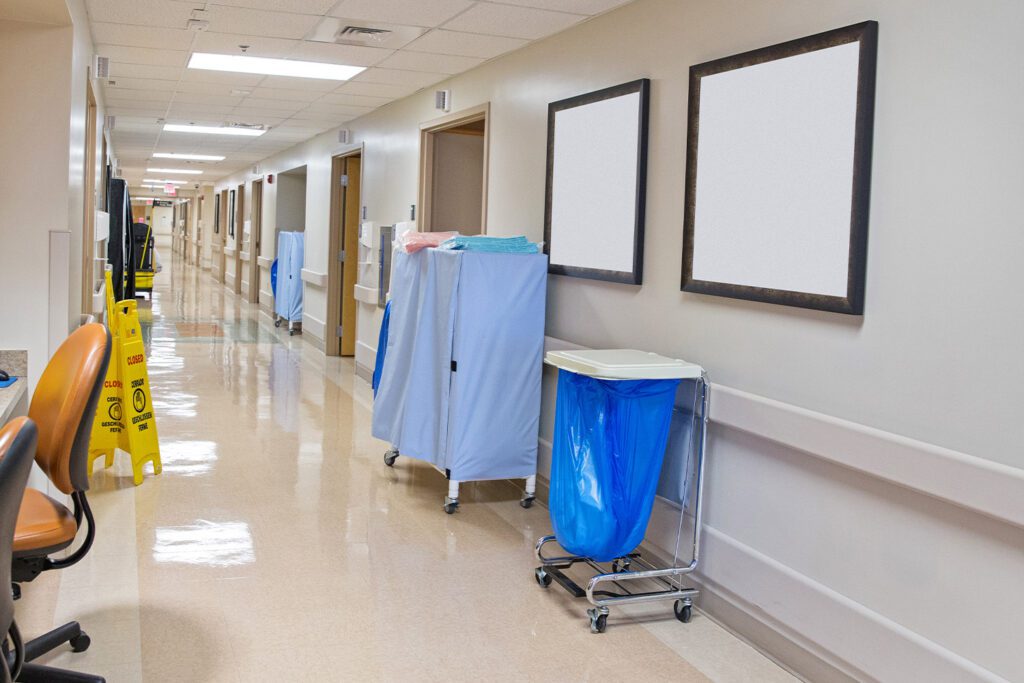How can hospitals deliver sustainable waste and material management?
The materials and supplies needed in healthcare settings – and the waste generated – may not be the first thing that comes to mind when thinking about hospitals.
But the logistics involved in material supply and the management of operational waste are essential elements that ultimately contribute to patient wellbeing. In this piece, we look at the critical role that these systems play in ensuring peak efficiency– and how they can be implemented in a manner that meets sustainability and net zero targets.
A hospital is an unusual building. It differs from an office block, a home, a university or a museum in a myriad of ways, but one is of paramount importance: its occupants. Patients are a unique differentiator from all other settings, and their experience and safety must take priority. If all systems are not expertly implemented, patient wellbeing and safety can be affected. This includes the many materials and supplies that are required for all healthcare operations to be effectively and efficiently undertaken.
Materials and waste
Materials management and handling – and disposal of subsequent waste – in hospitals is rarely as efficient and effective as it could be. The amount of materials and supplies within a healthcare setting is huge; a hospital relies on the correct equipment. ‘Materials’ in a hospital refers to any supplies and items that are required to facilitate the delivery of care.
These are medical supplies, consumables and surgical items that are used once then disposed of after use, as well as materials that are used more than once (such as appropriately sterilised surgical instruments, and equipment such as trolleys, staff uniforms and linens).

Associated waste can be defined as clinical (from patient care) and non-clinical. Effective management of both types of materials can increase efficient running of the systems and reduce the amount of associated waste. Work undertaken by Buro Happold at Landspitali Hospital, Reykjavik, Iceland demonstrates the innovative way that material waste can be dealt with. Our waste management teams developed the logistics for the hospital’s waste and linen vacuum collection system and designed an auto-guided vehicle (AGV) goods distribution system.
Inefficiencies and their impact
Inefficiencies in how material and waste logistics are implemented within hospitals can have serious impacts. The type of inefficiencies naturally differs between different sites, but there are certain commonalities that consultants can identify. Jose Sorribes, associate waste and logistics consultant at Buro Happold, is an expert in waste management and operational logistics. He said, “A main issue is lack of space and lack of proper facilities to handle these materials. Most of the time, that’s due to hospitals being too old.
“Some may have been refurbished, but the facilities have not kept up with the demand. Even new hospitals are not exempt; we often find that new designs do not sufficiently plan for the management of waste and materials. We see issues around space planning, insufficient space, and vertical and horizontal connectivity. These things are essential to transport materials in and out of hospitals, but we often see that these facilities have not been properly considered.
“A primary inefficiency that we see is that their systems for the management of materials and waste are suboptimal in most cases, and hugely inefficient in many cases. This forces clinical staff to become involved in material management or to spend time looking for these materials.”
Logistical tasks such placing orders, looking for the right supplies and replenishing storage rooms is time that removes staff from deploying their skills on what they were trained: taking care of patients. A streamlined materials management strategy can increase positive patient experience, comfort and safety.
There is a difference between a hospital and any other building; if the right supplies in a hospital are not available, people can be harmed.
Jose Sorribes, associate waste and logistics consultant
Waste management and logistics consultants from Buro Happold were involved in the development of the Hospital of the Future. This research and design prototype project considered questions like: what should the hospital of the future look like? How can we rethink hospital design for the healthcare needs of tomorrow? A principal outcome was the importance of holistically considering patient wellbeing and recovery: multiple factors feed into patient experience.
It included work from Buro Happold’s waste and logistics consulting team who advised on a super-fast automated goods and waste system that would remove the need for manual handling of goods and waste, and enable on-demand delivery. This system would maximise the potential of the horizontal plane, offering more storage areas, removal of clashes and more direct deliveries.
A transport system would use automated and group rapid transit vehicles to support patient and staff movement. Work on the Hospital of the Future is an example of how an optimal logistics strategy requires a robust hospital design that recognises its importance and helps successful integration.
‘Right place, right time’
All departments in a hospital require supplies. If they are not available in the right place, at the right time and in the right quantities, then patient care cannot be delivered to the required standard. Jose Sorribes said, “Nurses and doctors end up having to spend a lot of time managing these materials and doing things that are related to logistics and waste management, which is not what they should be doing; it takes away time they should be spending taking care of patients.
“It is not making best use of their time, and this can deteriorate clinical staff morale and contribute to burnout. At a time where staff retention and morale are low, this is a real concern.”

If doctors, nurses and healthcare workers don’t have the right materials, at the right time, to be able to deliver care, patients will not get the treatment they need. Material delivery means the right quantities at the right time, in the right place. Jose Sorribes said, “You need a really efficient system. And the consequences of not having the materials when you need them can be harmful or even fatal.
“That is the difference between a hospital and any other building; if the right supplies in a hospital are not available, people can be harmed. It is not an ordinary building. The same principle applies to waste management. Hospitals produce infectious waste and if the right system is not in place to get rid of this waste in a safe way, infection can spread and harm people.”
Appropriate provision for clean, hygienic and efficient goods delivery and waste management flows ensures that staff skills are used where they are most needed. James Hobson is head of waste operations logistics flows at Buro Happold. He said, “A key commodity in this context is time. Looking at materials saved from landfill is one thing, but if you can free up 10% or so of a member of clinical staff’s time, that is priceless. I hear so often about how long staff have to take to simply look for things – be that thermometers or blood pressure monitors or even a wheelchair or stick – that have been moved or aren’t where they need them to be.”
How can we balance sustainability with patient safety and wellbeing?
Healthcare settings are as prone to sustainability concerns as the rest of the world, so how can these concerns be addressed without comprising patient care? There can be a perception that implementing sustainability practices will come at the expense of quality patient care. This is untrue in most cases.
A change of mindset is needed: careful consideration of effective logistical waste flows does not simply improve the environmental performance of a hospital; it is critical in ensuring patient wellbeing. If all systems are not efficient and operating at an optimum level (including streamlined materials and waste organisation and delivery), then patients cannot receive the appropriate level of care and attention.
It is undeniable that healthcare systems are under increasing pressures. The rate of chronic diseases around the world are increasing and more people need medical care. That means that health care is under pressure to continue to deliver more care, but in a way that does not does not cause harm to the environment and local communities. That includes prudent minimising of the use of resources and generation of waste where possible.
Something that consultants in this space often identify is the lack of standardisation of materials. Different versions of the same items across departments are common. Streamlining and rationalisation should be an area of focus. This can yield carbon savings (reduced transportation), create space and reduce costs. In some cases, it is possible to identify areas where re-use is sensible and appropriate; this can include personal protective equipment (PPE) and surgical supplies. This can provide both operational cost and patient care benefits, avoiding supply chain disruptions and continuity of patient care.
Engaging with clinical staff is key. They are the people who are on the ground working with patients, who need to use materials and who handle waste every day.
Jose Sorribes, associate waste and logistics consultant
Expert consultants have certain responsibilities and key considerations when addressing all these sustainability concerns in the context of waste and materials management, while ensuring high level of patient care and wellbeing.
Jose Sorribes explains his approach. “We must understand what the baseline situation is and identify if there are some easy-wins or areas where these initiatives could make the biggest difference. We should start small, refine our approach and then roll out at a bigger scale. This could include doing a pilot study in a single department. And finally, engaging with clinical staff is essential.”
Engaging with clinical staff
An increased focus on the role that effective waste and material management in healthcare can play in improved patient wellbeing is something that is only slowly coming into view. Jose Sorribes explains that this “is an emerging area and we haven’t seen others who specialise in healthcare waste and logistics. Often the people working in waste and materials are operators, not consultants, and they might not know what is available out there for them. That’s where we come in. I think we can help them find their way through it.
“Engaging with clinical staff is key. They are the people who are on the ground working with patients, who need to use materials and who handle waste every day. We want to talk to those people immediately at the beginning of a project. We engage with facilities management teams to learn how they work or are planning to work. How do they run the materials and waste operations? What’s working, what’s not working? What’s the day in the life like for them?
“It is important to talk to everyone, from catering to pharmacy to those on wards and everyone in between. There may be different issues and different viewpoints from different teams, so we must take all these on and work on solutions that suit everyone.”

James Hobson said, “One of my favourite parts of this kind of work is engagement with staff in hospitals. We go in and hear problems, and then we know that we have the ability to fix them. Traditional consulting on this looks at the prevention of generation of waste coming out of hospitals so it’s all quite mechanical, but we are able to consider how can the hospital be designed to better manage waste in the first place or reduce the need for certain products coming in.”
A comprehensive plan for effective, efficient materials management and handling in hospitals will ensure high levels of patient safety and positive clinical outcomes, low servicing costs, peak efficiency, removal of logjams and maximising of sustainability performance.

